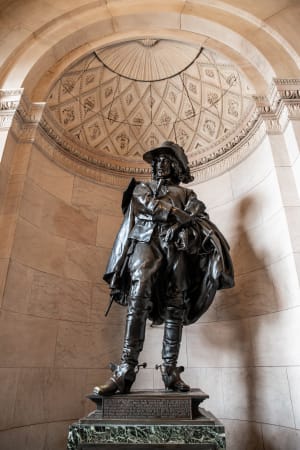Sir Henry Vane (1613 - 1662) — Discovering an extraordinary life and legacy
Monday, Jun 24, 2024 11:00a -
12:00p
Where:
Online event
Admission:
FREE
Categories:
Art, History, Lectures & Conferences, Virtual
Event website:
https://bpl.bibliocommons.com/events/65fdd9f58b48e73a00d4af39
In the vestibule of Boston Public Library is a single sculpture of 17th century English parliamentarian, Sir Henry Vane. Sculpted by Frederick William MacMonnies (1863-1937), this artwork was gifted to the Library in 1897 by Brookline doctor, Charles G. Weld, presented in honor of James Freeman Clarke, the American theologian, abolitionist, and a BPL trustee. But why was this little-known figure chosen as the subject of such a prominent piece of art in one of Boston’s best loved buildings?
This program will happen online over Zoom webinar. Please register here.
In 1662 Sir Henry Vane was executed at Tower Hill, London, described by the newly crowned King Charles II as “too dangerous to let live”. Almost forgotten in his native England, Vane is a tantalizing and complex character; idealist, family man, religious radical, parliamentarian and statesman all in one.
As a young man, Vane followed his Puritan convictions to Massachusetts Bay, briefly serving as Governor in 1636, a role for which he was woefully ill-equipped, but during which time which he developed friendships with the Cottons, Hutchinsons, Dyers and Roger Williams who later described him as “an Instrument of God” for procuring and confirming the Rhode Island Charter. Although an opponent during the 1630s, John Winthrop would later describe him as a “true friend of New England”, a quotation that is referenced on the sculpture’s dedication plaque. On returning home, Henry rose to prominence alongside Oliver Cromwell and the Parliamentarians, a cause for which he would eventually lose his life.
Today, Vane is remembered at his family home, Raby Castle (still owned by the Vane family), whose curator Julie Biddlecombe-Brown has been trying to piece together his story from his writings, family papers and various biographies, all of which capture an aspect of the man, but struggle to present the full picture. In this short talk, specially written for the Boston Public Library, Julie aims to piece together aspects of Henry’s life and explores a complex legacy that sees him commemorated on the Boston sculpture as “an Ardent Defender of Civil Liberty and Free Thought in Religion”.
About the presenter
Julie Biddlecombe-Brown is an experienced curator who heads up the Curation and Archives team atRaby Castle on behalf of the current owners, Lord and Lady Barnard. She previously worked as Curator of Exhibitions at Durham University where she first began looking at the links between New England and the north-east of England in 2016 as part of a project team telling the story of indentured Scottish prisoners who were sent to Massachusetts Bay in 1650. Since moving to Raby Castle in 2019, Julie and her team have been getting to grips with a site with almost 1,000 years of history; over 15,000 historic items and 2,500 feet of archives, a process that uncovers stories that demonstrate that the castle might have roots firmly planted in England but its branches spread across the globe.
Accessibility Notice: We strive to make our events accessible. To request a disability accommodation and/or language services, please contact the Adult Programs Department at [email protected] or 617-859-2129. Please allow at least two weeks to arrange for accommodations.
Cover media information: Statue of Sir Henry Vane (1612-1662), governor of the Massachusetts Bay Colony in 1636 and 1637, by Frederick William MacMonnies (1863-1937)
-

SponsoredRockport Guided Coastal Kayak or SUP Excursion from Boston
Saturday, Jul 05, 2025 12:30p
Rockport Harbor
-

SponsoredDay Trip from Boston: Kayak Castle Neck River at Crane Estate
Saturday, Jul 05, 2025 11:30a
Crane Beach
-

Sponsored -

SponsoredExplore The New England Botanic Garden at Tower Hill: Day Trip from Boston
Sunday, Jul 06, 2025 11:00a
New England Botanic Gardens at Tower Hill
-

SponsoredCurated Cuisine: Let’s talk lobster with Row 34’s Jeremy Sewall and Select Oyster’s Michael Serpa
Monday, Jul 14, 2025 6:30p
WBUR CitySpace
-

SponsoredAffordable Spanish Classes in Boston (in-person and online courses) | BASE
Monday, Jul 07, 2025 goes until 07/18
Boston Area Spanish Exchange (BASE)
-

SponsoredGuided Tour of Historic Castle Hill o n the Crane Estate: Round Trip Transportation from Boston Included!
Saturday, Jul 05, 2025 11:30a
Crane Estate


